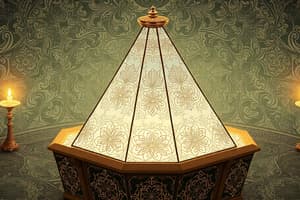Podcast
Questions and Answers
Match the following with their description:
Match the following with their description:
Two congruent lateral faces = Triangles with the same base as the base triangle but half the height One base face = A triangle of the same shape as the base triangle Two top faces = Congruent to the lateral faces but facing upward Total surface area of a triangular prism = Sum of the areas of all its faces
Match the following prerequisites with their concepts:
Match the following prerequisites with their concepts:
Triangle Properties = Properties of triangles such as area, perimeter, and Heron's formula Area and Perimeter = Difference between area and perimeter of two-dimensional shapes Prism Formulas = Surface area formulas for regular prisms and irregular prisms like triangular prisms Understanding surface area of triangular prisms = Knowledge needed to calculate the surface area of a triangular prism
Match the following components with their roles in a triangular prism:
Match the following components with their roles in a triangular prism:
Two congruent lateral faces = Triangular faces with half the height of the base triangle One base face = Triangle that forms the bottom of the prism Two top faces = Congruent to lateral faces but facing upward Total number of faces in a triangular prism = Sum of lateral, base, and top faces
Match the following terms with their meanings:
Match the following terms with their meanings:
Match the following components of a triangular prism with their corresponding area calculation:
Match the following components of a triangular prism with their corresponding area calculation:
Match the following descriptions with their corresponding component of the total surface area of a triangular prism:
Match the following descriptions with their corresponding component of the total surface area of a triangular prism:
Match the following symbols with their respective meanings in calculating the total surface area:
Match the following symbols with their respective meanings in calculating the total surface area:
Match the following statements with their correct representation in calculating total surface area:
Match the following statements with their correct representation in calculating total surface area:
Study Notes
Understanding the Surface Area of Triangular Prisms
A triangular prism is a three-dimensional shape formed by connecting a base triangle with two congruent, parallel triangles. It's a classic example of a prism, and like any other prism, the surface area is a fundamental aspect to comprehend. In this article, we'll explore how to calculate the total surface area of triangular prisms.
Prerequisites
Firstly, let's review some essential concepts you'll need to understand before diving into calculating the surface area of triangular prisms:
- Triangle Properties: Familiarity with the properties of triangles, such as area, perimeter, and the Heron's formula for finding the area of a triangle with three sides.
- Area and Perimeter: Understanding the difference between the area and perimeter of a two-dimensional shape and how to calculate them.
- Prism Formulas: Knowledge of the surface area formulas for regular prisms and how they differ from irregular prisms, like triangular prisms.
Surface Area Components of Triangular Prisms
A triangular prism has six faces, three on each side of the base triangle. The faces can be divided into:
- Two congruent lateral faces: These are triangles with the same base as the base triangle but half the height.
- One base face: The base face is a triangle of the same shape as the base triangle.
- Two top faces: These are congruent to the lateral faces, but facing upward.
Calculating the Surface Area
To calculate the total surface area of a triangular prism, you'll need to find the area of each face type and then sum them up.
-
Lateral faces: Since they are congruent triangles, one has an area equal to half the area of the base triangle. Let's call this area (A_l) and the base of the lateral face as (b_l). Then, (A_l = \frac{1}{2} \cdot \text{Area of the base triangle}).
-
Base face: The area of the base face is equal to the area of the base triangle, which is denoted as (A_b).
-
Top faces: These are congruent to the lateral faces, so their area is also equal to (A_l).
Now, we can find the total surface area ((TSA)) by adding the area of each face type:
[ TSA = A_l + A_b + 2A_l = A_l + A_b + 2\cdot A_l = (A_l + A_b) + 3A_l = \left(\frac{1}{2} \cdot \text{Area of the base triangle}\right) + 3\cdot\left(\frac{1}{2} \cdot \text{Area of the base triangle}\right) ]
Finally, substitute the area of the base triangle, (A_b), for (\frac{1}{2} \cdot b_b \cdot h_b), where (b_b) is the base length of the base triangle and (h_b) is the height of the base triangle.
[ TSA = \left(\frac{1}{2} \cdot b_b \cdot h_b\right) + 3\cdot\left(\frac{1}{2} \cdot b_l \cdot h_l\right) ]
Summary
Now you have the tools to calculate the surface area of triangular prisms. The surface area consists of the area of the base triangle, two congruent lateral faces, and two top faces, which are congruent to the lateral faces. The total surface area is calculated by finding the area of the base triangle and then doubling the combined area of the lateral and top faces.
Studying That Suits You
Use AI to generate personalized quizzes and flashcards to suit your learning preferences.
Description
Learn how to calculate the total surface area of triangular prisms by understanding the components and formulas involved. Discover the areas of the base triangle, lateral faces, and top faces, and how they contribute to the overall surface area of a triangular prism.




